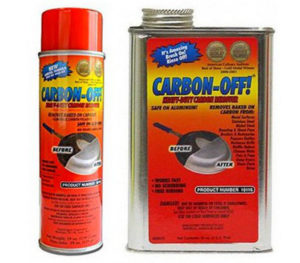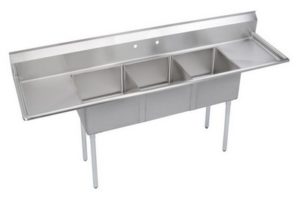One of the most important factors, if not the most important factor that commercial foodservice operations must manage on a daily basis is the cleanliness of their facilities. The cleanliness of your establishment is important for several reasons: the health and safety and your patrons and staff, the efficiency of production and service, and the reputation of your business. In this blog series, The Power of Clean, we will be talking about the power of cleanliness to make a difference in your own establishment. We will be covering several areas that need attention in both the front and back of the house and recommend products to help keep your facilities spotless. We will link to these products in our online store as they are mentioned in the blog, so be sure to click the links to view and shop for these products online.
We will begin with cookware. The cleanliness of the cookware in your establishment has the power to affect the efficiency of production and service. Not only that, but it has the power to affect the health and safety of your customers because any one piece of cookware is a food contact surface. Microorganisms that cause foodborne illnesses (also known as pathogens) need certain conditions to thrive. Among those conditions are the presence of foodstuff and moisture. Therefore, it is vital to ensure that all cookware is spotless and dry before and after use. The best way to do this is to follow the proper procedures for the setup and use of your three-compartment sink.
For sink setup, first clean and sanitize each bowl and drainboard of the sink. Next, fill the first sink with hot water and detergent. The temperature of the water should be at least 110°F. Next, if your sink is equipped with a faucet rather than a pre-rinse assembly, fill the second sink with clean water for immersion rinsing. This step is not necessary if your sink is equipped with a pre-rinse assembly, as the items can be spray-rinsed instead of immersed. Finally, fill the third sink with water and sanitizing solution to the proper concentration according to the sanitizer manufacturer’s recommendations. The proper concentration should be verified using sanitizer test strips. A clock with a second hand near the sink is recommended so that your staff can track how long items have been submerged in the sanitizer. The cookware must be submerged in the sanitizing solution for at least 30 seconds to effectively kill any pathogens.
Once the sink is properly set up, you are ready to begin washing. For proper cleaning and sanitizing, the following steps should be followed: First, rinse or scrape items of excess soil before washing them. Next, in the first sink with the detergent, using a tool such as a scrub brush, scouring pad, or stainless steel sponge, clean all sides of the cookware making sure that all soil and foodstuff are removed. Be sure to change out the wash water as needed, when either the suds are gone, or the water becomes dirty or greasy. Next, in the second sink, either spray-rinse the cookware using your pre-rinse assembly or submerge it in the rinse water. Make sure the cookware is free of any remaining detergent or foodstuff. If you are submerging items rather than spraying them, be sure to change out the rinse water as often as needed. Finally, submerge your cookware in the third sink with the sanitizing solution. Do not rinse any items after they have been sanitized. Rinsing items in the used rinse water after they have been sanitized can contaminate the surfaces. Finally, air-dry the items using a clean and sanitized surface. You can use either the drainboard on the clean side of the sink or clean and sanitary storage shelves. For best results, use epoxy coated wire shelving. Be sure to turn the cookware upside-down to ensure proper drying. Also, avoid stacking items during the drying process. This will avoid “wet-nesting” where moisture can pool and accumulate, thus providing moisture for pathogens to thrive. If you follow these simple steps, you can be sure that your cookware will be as clean and sanitary as possible.

Safe for cookware metals, Carbon-Off® dissolves even the toughest buildup of grease and carbon with ease.
But what about built-up grease and carbon on the outside of your cookware? This kind of buildup is common on cookware used on commercial ranges. This grease and carbon buildup can actually be a breeding ground for pathogens and can also hinder the efficiency of your cookware by interfering with the transfer of heat from the cooking equipment to the pan surface. It may be tempting to use oven cleaner to break up this kind of tough buildup but oven cleaner can actually harm the metal surface of your cookware. That’s where Carbon-Off® comes in. Safe for cookware metals, Carbon-Off® dissolves even the toughest buildup of grease and carbon with ease. Simply apply Carbon-Off® to the outer surface of the cookware, allow to soak in for about 15 minutes, and the buildup will loosen up and release from the pan. Next, simply wash the surface under cold running water using a scouring pad, and the carbon build-up will wash away into the drain without any need for vigorous scrubbing or scraping! Carbon-Off® is fast and effective, and will have your cookware looking and performing like new! Be sure to have eye protection and gloves and that you are in a well-ventilated area before using Carbon-Off®!
In summary, clean and sanitary cookware has the power to make a difference in your foodservice establishment. Properly cleaned and sanitized cookware will maintain cooking efficiency and protect the health and safety of your customers and staff. You can find the products we mentioned in this blog post in our store at 3110 Preston Hwy in Louisville, KY, or you can shop online at shop.dinecompany.com. For more information, please call 1-877-346-3830 to speak to a customer care associate.


